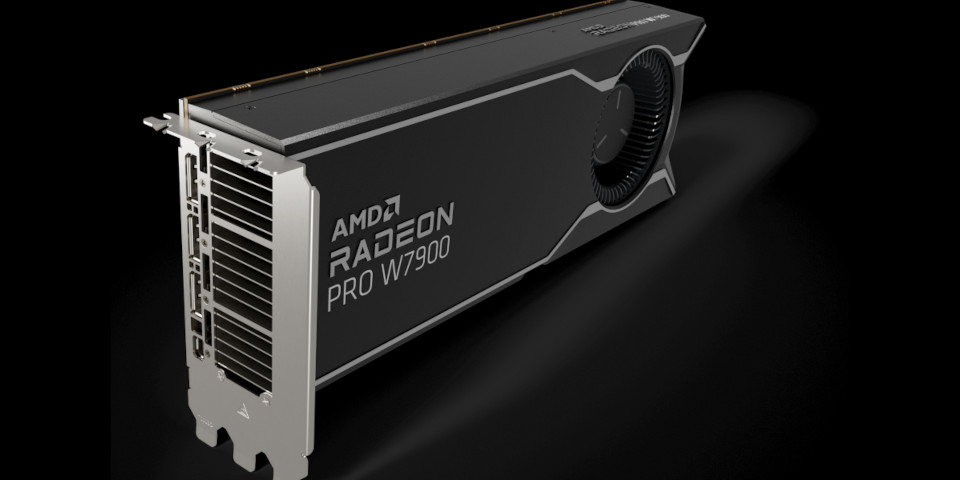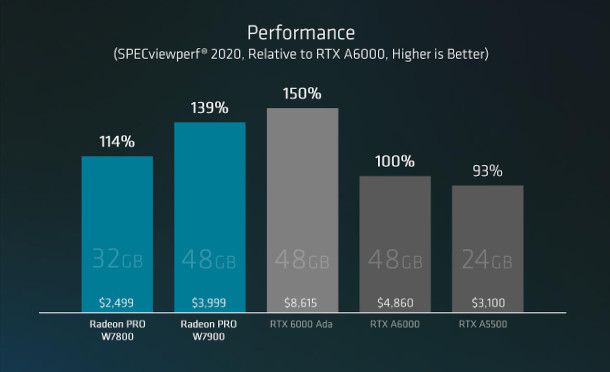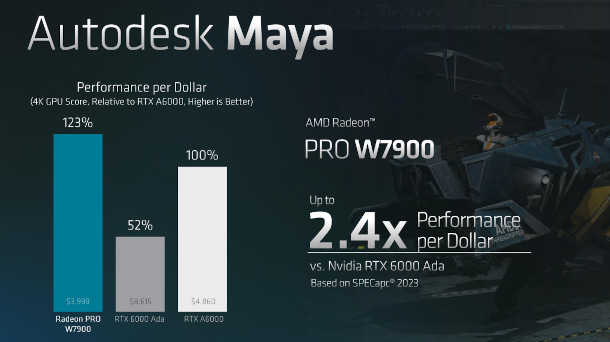AMD unveils Radeon Pro W7900 and W7800 GPUs

AMD has unveiled the Radeon Pro W7900 and Radeon Pro W7800, the first workstation GPUs based on its new RDNA 3 architecture, and the first cards in its Radeon Pro W7000 Series.
The $3,999 48GB Radeon Pro W7900 and $2,499 32GB W7800 will form the new high end of AMD’s workstation GPU line-up when they ship later this quarter, and are aimed at professional DCC and CAD work.
The first workstation cards to use AMD’s new RDNA 3 GPU architecture
The Radeon Pro W7900 and W7800 are the first workstation cards to use AMD’s new RDNA 3 GPU architecture, rolled out last year in the firm’s Radeon RX 7000 Series gaming cards.
As with AMD’s previous RDNA 2 architecture, it includes dedicated hardware cores for general GPU computing, including raster rendering, and for hardware-accelerated ray tracing.
The design of the ray accelerators has been improved, with AMD claiming that RDNA 3 provides “approximately 50% more ray tracing performance per compute unit” than RDNA 2.
To that, RDNA 3 introduces new dedicated AI accelerators, delivering “over 2x more performance” than RDNA 2, native AV1 encoding and decoding, and AMD’s Radiance Display Engine.
The latter supports DisplayPort 2.1, the latest version of the digital display standard, which will make the Radeon Pro W7900 and Radeon Pro W7800 the first professional cards to support DisplayPort 2.1.
| AMD workstation GPUs | ||||
|---|---|---|---|---|
| Radeon Pro W7900 | Radeon Pro W7800 |
Radeon Pro W6800 |
Radeon Pro W6600 |
|
| Architecture | RDNA 3 | RDNA 3 | RDNA 2 | RDNA 2 |
| Stream processors |
6,144 | 4,480 | 3,840 | 1,792 |
| Compute units | 96 | 70 | 60 | 28 |
| Ray accelerators | 96 | 70 | 60 | 28 |
| FP32 compute performance (Tflops) |
61.3 | 45.2 | 17.8 | 10.4 |
| GPU memory | 48GB GDDR6 |
32GB GDDR6 |
32GB GDDR6 |
8GB GDDR6 |
| Memory bandwidth (GB/s) |
864 | 576 | 512 | 224 |
| TBP | 295W | 260W | 250W | 130W |
| Slot width | 3 | 2 | 2 | 1 |
| Display | 3 x DP 2.1 1 x MiniDP 2.1 |
3 x DP 2.1 1 x MiniDP 2.1 |
6 x MiniDP 1.4 |
4 x DP 1.4 |
| Release date | 2023 | 2023 | 2021 | 2021 |
| Launch MSRP | $3,999 | $2,499 | $2,249 | $649 |
Key specifications and prices
The two new cards form the high end of AMD’s line-up of workstation cards, with the Radeon Pro W7800 targeted at ‘heavy’ workloads, and the W7900 at ‘extreme’ workloads.
On paper, the Radeon Pro W7800 is a considerable advance over its previous-generation counterpart, the Radeon Pro W6800, at least in terms of raw compute power.
The comparatively small increase in Stream processor count belies an increase in FP32 compute performance of close to 3x, with the W7800 notching up 45.2 Tflops, compared to the W6800’s 17.8 Tflops.
GPU memory capacity is unchanged, at 32GB, although memory bandwidth rises slightly, as do power consumption and the recommended launch price.
The Radeon Pro W7900 is a step beyond the W7800, with a FP32 performance of 61.3 Tflops and 48GB of higher-bandwidth GPU memory, but also increased power consumption, and a higher recommended price.

AMD’s perfomance comparison of its Radeon Pro W7800 and W7900 cards to Nvidia workstation GPUs, presented as a geometric mean of SPECviewperf 2020 scores, which include 3ds Max, Maya and CAD apps.
Benchmark results in DCC and CAD software
AMD has released a range of benchmark results for the new cards, including DCC applications, compositing and video editing software, and CAD and architectural visualization tools.
The Radeon Pro W7800 is compared to Nvidia’s RTX A5500 which, although the closest equivalent in Nvidia’s current line-up of workstation cards, is a previous-generation card with less GPU memory.
In that light, it perhaps isn’t surprising that AMD reports a geometric mean of SPECviewperf 2020 benchmark scores 23% higher than the Nvidia card.
However, it is worth noting that the RTX A5500 has only been out for a year, so it seems reasonable to assume that that the two cards will go head-to-head for some time.
The Radeon Pro W7900: more bang for your buck than equivalent Nvidia cards?
The Radeon Pro W7900 gets a more interesting comparison: to Nvidia’s RTX 6000 Ada Generation – like the W7900, a current-generation 48GB card.
Here, AMD focuses on price-performance rather than absolute performance, since the the RTX 6000’s SPECviewperf 2020 geometric mean score is actually 8% higher than that of the Radeon Pro W7900.
However, the RTX 6000 is a more expensive card, with a recommended launch price of $6,799, compared to $3,999 for the Radeon Pro W7900, which suggests that the W7900 will offer more bang for your buck.

AMD’s price-performance comparison between its new Radeon Pro W7900 and Nvidia’s 48GB workstation GPUs. Be aware that the comparision uses street prices for the Nvidia cards collected by AMD itself.
AMD also claims that the Radeon Pro W7900 outperforms the RTX A6000, Nvidia’s previous-generation 48GB card, which is still available with a street price around its recommended launch price of $4,649.
Here, AMD quotes a SPECviewperf 2020 geomean score 39% higher for the W7900 than the RTX A6000.
AMD has also released individual application benchmarks – although all are presented in terms of price-performance, which AMD calculates using a relatively high street price of $4,860 for the Nvidia card.
With that caveat noted, we’ve included AMD’s Maya benchmark above, tested using SPECapc 2023.
The relative price-performance for the two cards is similar across AMD’s tests for After Effects and DaVinci Resolve, both benchmarked with PugetBench, and Lumion, using Lumion’s example projects.
Caveats and limitations of AMD GPUs in production
Obviously, those are AMD’s own figures, and use synthetic benchmarks rather than production scenes, so it will be interesting to see if they are confirmed by independent tests.
For DCC work, it’s also important to note that several key GPU render engines, including Arnold GPU, OctaneRender and V-Ray GPU, use Nvidia APIs, and are not accelerated on AMD graphics cards.
However, some formerly Nvidia-only renderers have recently announced support for AMD GPUs, with Maxon releasing an AMD-compatible version of Redshift in closed alpha, with a public beta expected this year.
Price and availability
The Radeon Pro W7900 and Radeon Pro W7800 are expected to become available from e-tailers in “Q2 2023”, The W7900 has a MSRP of $3,999 and the W7800 has a MSRP of $2,499.
Read more about the Radeon Pro W7900 on AMD’s website
Read more about the Radeon Pro W7800 on AMD’s website
Full disclosure: in my life outside CG Channel as a freelance technical writer, I have worked on promotional material for the Radeon Pro W7000 Series for AMD.
